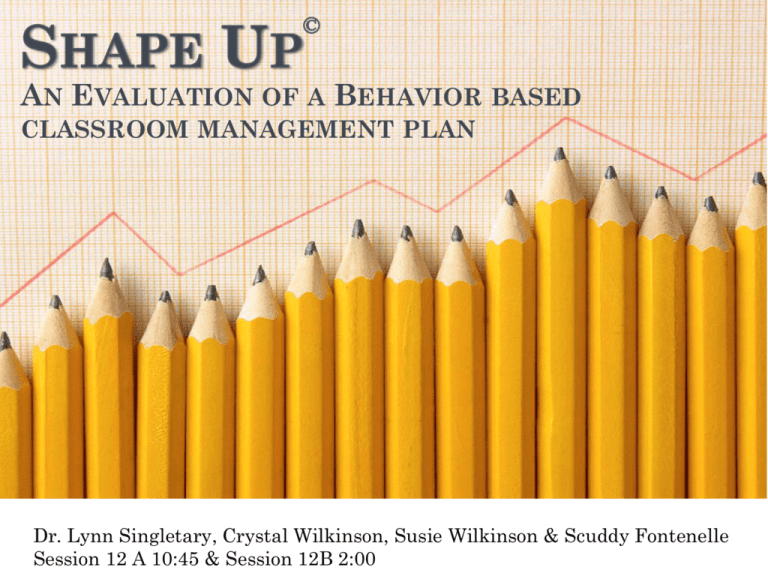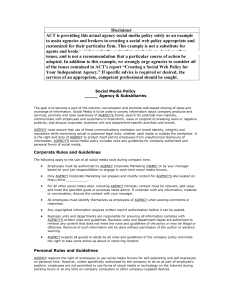Shape Up - Positive Behavior Intervention and Supports | Louisiana
advertisement

AN EVALUATION OF A BEHAVIOR BASED CLASSROOM MANAGEMENT PLAN Dr. Lynn Singletary, Crystal Wilkinson, Susie Wilkinson & Scuddy Fontenelle Session 12 A 10:45 & Session 12B 2:00 PRIMARY LEARNING OBJECTIVES Learn the Difference Between Traditional Classroom Management & the Shape Up program. Learn How Shape Up Fits within the PBIS System. See What Progress Monitoring of Social Behavior Looks Like (i.e., objective grading scale, computer data-based system and change criteria) Learn the outcomes of our study that investigated the impact of Shape Up on student on task behavior THE SITUATION Our schools are more diverse then ever before Students are exposed to higher levels of stress (i.e., environmental, parental, peer, community, national, etc.) More and more students are entering school lacking school academic and social skills Discipline continues to be cited year after year as the number one concern facing educators (Phi Delta Kappa / Gallup Poll) Teacher Education programs continue to lack classes in understanding the science of human behavior PBIS School wide Classroom Routines Academic Behavior Walking in Halls Reading Restroom use Writing Behavior Class Cafeteria use Math Shape Up TRADITIONAL BEHAVIOR MANAGEMENT Concerned with “managing” students across the day. It is a combination of routines and procedures, work habits, and conduct. Grades are subjectively assigned Students that are socially challenging are “talked about” or blamed for their problem behaviors Antecedents are the rules Consequences are often given at the point of frustration Consist of reprimands, redirections, and thousands of warnings all with the hopes of “fixing the child” POSITIVE BEHAVIOR SUPPORT PBS is a decision making framework that guides selection, integration, and implementation of the best evidence-based academic and behavioral practices for improving important academic and behavior outcomes for all students views systems, settings, and lack of skill as part of the “problem” is long term and provides a support system (www.PBIS.org) www.PBIS.org Shape Up program was developed as a Tier 1 class-wide approach to shaping student appropriate social behaviors. The program employs the use of behavior class, behavioral rules, systematically applied consequences that increase and or decrease behaviors, a tracking mechanism, and progress monitoring of social behaviors. Academic, Arts, PE Instruction Classroom Management (Reading, Writing, Math, Social Studies, Science, Art, PE, Music) (Routines and Procedures) Shape Up Behavior Class (Classroom Rules & Socially Appropriate Behavior ) Shape Up is founded on the principles of Behavioral Science •Behavior is learned •Behavior comes under the control of environmental factors •Behavior can be changed Shape Up not only prevents problems from occurring but teaches appropriate social behavior •First learn the rules (behavior class) •Second practice rule following behavior •Third learn prosocial skills 8 COMPONENTS OF SHAPE UP 1 Expectations / Rules of Conduct Train observable & measurable behaviors 2 Behavior Class Positive Practice, Social Skills Class 3 Positive & Negative Consequences Reinforcement Schedules / Incentives / Penalties 4 Daily Tracking System Accountability 5 Grading Scale Behavioral Performance Levels 6 Progress Monitoring Evaluate Progress 7 Shape Raise Expectations / Change Criteria (reinforcement schedule, grading scale) 8 Ongoing training and support Students engaging in disruptive behavior (Intervention) 8 Shape Up Components fit within 4 PBS Elements Systems Data 1. Expectations/ Rules of Conduct 3. Pos/Negative Consequences 4. Daily Tracking 5. Grading Scale 6. Progress Monitoring 7. Shape Practices 2. Behavior Class 4. Daily Tracking 8. Ongoing Training and Support Progress Monitor Evaluate Implement Next Steps The Excelyzer© 1. 2. 3. 4. Enter students names in the first 2 columns Click on a predefined grading scale or create a custom scale Type the date Enter the number of rule violations for each student for each day -either daily or at the end of the week. THE STUDY: WE INVESTIGATED THE EFFECTS OF A BEHAVIORALLYBASED CLASSROOM MANAGEMENT PROGRAM (SHAPE UP) ON TEACHER AND STUDENT BEHAVIOR. Single subject multiple baseline across 3 subjects design. Data collection included: •Interview information •direct observation of teachers, and student on and off task behaviors, •teacher tracker records, •student conduct cards, •program implementation (i.e., program integrity), •progress monitoring data(i.e., Excelyzer©), and •social validity information. STUDY PHASES Baseline: Teacher Developed Classroom Management Plan Phase I: Shape Up Plan w/o Feedback Phase II: Shape Up Plan w/ Feedback PHASES •Baseline: teachers were interviewed and observed to determined present classroom management strategies and the impact on student behavior. •teachers received a 2-hour training on the SU program along with support to prepare their classrooms for the new plan. •Consultants supported teachers during student training day •Phase I: Subsequent observations were conducted to collect information on the use of Shape Up. Teachers did not receive feedback. •Phase II: Observations were conducted and teachers were given feedback about adherence to the program and student on and off task behaviors. TEACHER DEMOGRAPHICS T1 T2 T3 Gender Female Female Female Education Attained B.S. B.S. B.S. University Attended LSU LSU LSU Type of Certification Grades 1-8 Grades 1-8 Grades 1-6 Years of Experience 15 4 2 Grades Taught 1st, 3rd, & 4th 1st 1st Present Teaching Position/ #Students 1st Grade / 23 students 1st Grade / 24 students 1st Grade / 13 students # Classes in Psych/Clr.Mgt 1 2 3 TEACHER INTERVIEW: COMPARE TEACHER MANAGEMENT PLAN TO SHAPE UP PROGRAM 1 Expectations / Rules of Conduct All had rules & consequences posted 2-3 observable rules What was posted did not match what was tracked 2 Behavior class All teachers taught rules & routines the first week of school Stated used modeling, role play, repetition 3 Positive and Negative consequences all stated they thought they “gave too many warnings” All teachers had scheduled & random reinforcement (scheduled) Fun Friday if earned an A in conduct by Friday (random) Name on board if caught being good 4 Daily Tracking System Turned cards or moved a clip for rule violations All teachers used a paper tracker What was tracked on paper did not match moved clips or turned cards 5 Grading Scale All teachers had a daily grading scale (weekly average) 1=A, 2= A-, 3=B, etc. 6 Progress Monitor Teachers did not have a system of monitoring progress Tracked violations, gave grade, moved on 7 Shape All teachers used the same plan all year 8 Ongoing training and support Students with challenging behaviors were sent to the office, time out rooms, parents were called, and if very severe – students were referred to the school psychologist OBSERVATION DETAILS 20 minute sessions (AVG 26 sessions) 10 second intervals 6 students (3 target & 3 random) 9 Categories On-task (engaged in learning) Off-Passive Off (looking away from task, fidgeting) Rule Violations TO- talking out HF-keeping hands, feet objects to self A-out of area, appropriate use of furniture Area Teacher Behavior P-praise M- Match = implemented plan as stated or trained NM- No Match= did nothing D- Deviate= attended to behavior by redirecting or reprimand BAR GRAPHS OBSERVATIONAL DATA ACROSS PHASES 6 students (20 minutes sessions) On task Off (Passive + Rule Violations) Passive Off & Rule Violations T3 Average On & Off Task Across Phases T2 Average On & Off Task Across Phases T1 Average On & Off Task Across Phases 100% 100% 100% 80% 80% 80% 60% 60% 60% 40% 40% 40% 20% 20% 0% 0% BL Phase I ON Off Phase II 20% 0% BL Phase I ON Off Phase II BL Phase I ON Off Phase II T3 Average On, Off, & RV 1 T2 Average On, Off, & RV 1 T1 Average On, Off, & RV 1 Total Off Task 0.8 0.8 0.8 RV 0.6 0.6 0.4 0.4 0.4 0.2 0.2 0.2 0 0 BL On Phase I Phase II Off RV Passive 0.6 On Task 0 BL Phase I On Off Phase II RV BL Phase I On Off Phase II RV T1- AVG Attn. To Student On & Off Task (RV & PO) 1.00 0.90 0.80 0.70 0.60 0.50 0.40 0.30 0.20 0.10 0.00 BL Tot. Attn. Off Task Phase I Ignore/Not Attend Phase II Praise T2- AVG Attn. To Student On & Off Task (RV & PO) 1.00 0.90 0.80 0.70 0.60 0.50 0.40 0.30 0.20 0.10 0.00 BL Tot. Attn. Off Task Phase I Ignore/Not Attend Praise T3- AVG Attn. To Student On & Off Task (RV & PO) 1.00 0.90 0.80 0.70 0.60 0.50 0.40 0.30 0.20 0.10 0.00 BL Tot. Attn. Off Task Phase I Ignore/Not Attend Phase II Praise LINE GRAPHS ON = ON TASK FOR 10 SECONDS OFF = PASSIVE OFF + RULE VIOLATIONS T3 Total Students (3 random & 3 target) 1.00 0.90 Baselineteacher developed plan Phase 1: Shape Up w/o feedback Phase 2: Shape Up with feedback 0.80 0.70 0.60 0.50 0.40 0.30 0.20 0.10 0.00 time time time time time 1 2 3 4 5 time time time time 6 7 8 9 time time time time time time time time time time time time time time time time time 10 11 12 13 14 15 16 17 18 19 20 21 22 23 24 25 26 On Total Off T2 Total Students (3 random & 3 target) 1 Baseline- teacher developed plan Phase 2: Shape Up with feedback Phase 1: Shape Up w/o feedback 0.9 0.8 0.7 0.6 0.5 0.4 0.3 0.2 0.1 On Total Off time 23 time 22 time 21 time 20 time 19 time 18 time 17 time 16 time 15 time 14 time 13 time 12 time 11 time 10 time 9 time 8 time 7 time 6 time 5 time 4 time 3 time 2 time 1 0 T1 Total Students (3 random & 3 target) 0.90 Phase 1: Shape Up w/o feedback Baseline- teacher developed plan 0.80 Phase 2: Shape Up w/ feedback 0.70 0.60 0.50 0.40 0.30 0.20 0.10 0.00 time time time time time time time time time time time time time time time 1 2 3 4 5 6 7 8 9 10 11 12 13 14 15 On time time time time time time 16 17 18 19 20 21 Total Off time time time time time time 22 23 24 25 26 27 LINE GRAPHS STUDENT RULE VIOLATIONS Shape Up: T1 Total Rule Violations or Checks Across 31 Days 80 70 60 4 reinforcement time periods 3 reinforcement time periods 50 40 30 20 10 0 1 2 3 4 5 6 7 Grading Scale 0-3 A, 4B, 5C, 6D, 7+F 8 9 10 11 12 13 14 15 16 17 18 19 20 21 22 23 24 25 26 27 28 29 30 31 Feedback sessions began 80 Shape Up: T3 Total Rule Violations or Checks Across 37 Days 70 60 50 40 30 20 10 0-3A, 4B, 5C, 6-8D, 9+F 0-2A, 3B, 4-5C, 6D, 7+F 0 1 2 3 4 5 6 7 8 9 10 11 12 13 14 15 16 17 18 19 20 21 22 23 24 25 26 27 28 29 30 31 32 33 34 35 36 37 0-3 = Sticker 0-2 = Sticker Shape Up: T2 Total Rule Violations or Checks Across 36 Days 80 70 60 0-3A, 4B, 5C, 6D, 7+F 50 0-2A, 3B, 4C, 5D, 6+F 40 0-1A, 2B, 3C, 4D, 5+F 30 20 10 0 1 2 3 4 5 6 7 8 9 10 11 12 13 14 15 16 17 18 19 20 21 22 23 24 25 26 27 28 29 30 31 32 33 34 35 36 3 reinforcement periods 2 reinforcement periods LIMITATIONS NEXT STEP TEACHER SATISFACTION SURVEY Teacher Survey Teacher 1 Total AVG Teacher 2 Total AVG Teacher 3 Total AVG Average Teacher Survey per Survey Total Category Acceptability 20 21 0.95 15 21 0.71 20 21 0.95 55 63 0.87 Effectiveness 19 21 0.90 17 21 0.81 20 21 0.95 56 63 0.89 Timeliness 14 14 1.00 10 14 0.71 13 14 0.93 37 42 0.88 Training 21 21 1.00 21 21 1.00 21 21 1.00 63 63 1.00 Components/ Materials 33 35 0.94 31 35 0.89 34 35 0.97 98 105 0.93 Satisfaction 14 14 1.00 11 14 0.79 14 14 1.00 39 42 0.93 Totals 121 126 0.96 105 126 0.83 122 126 0.97 348 378 0.92 PRINCIPAL SATISFACTION SURVEY Principal Survey Principal Principal 1 Total1 AVG1 2 Total2 AVG2 Principal 3 Total3 Average Principal Survey per AVG3 Total Total Category Acceptability 18 21 0.86 21 21 1.00 21 21 1.00 60 63 0.95 Effectiveness 16 21 0.76 21 21 1.00 21 21 1.00 58 63 0.92 Timeliness 10 14 0.71 14 14 1.00 14 14 1.00 38 42 0.90 Training 17 21 0.81 21 21 1.00 21 21 1.00 59 63 0.94 Satisfaction 12 14 0.86 14 14 1.00 14 14 1.00 40 42 0.95 Totals 73 91 0.80 91 91 1.00 91 91 1.00 255 273 0.93 Susie Smith Total rule violations Student Name 6 Morning 8:30 – 11:30 Keep hands feet Objects Talk out to self of turn Voice level loud Keep hands walk stay feet in line assigned Objects Talk out properly area to self of turn 1 2 Afternoon 11:30 – 3:30 3 4 5 Voice level loud walk stay in line assigned properly area 6 7 8 9 10 Billy West 4 11 12 13 14 15 16 17 18 19 20 Amy Samson 0 21 22 23 24 25 26 27 28 29 30 31 32 33 34 35 36 37 38 39 40 WHY TRACK RULE VIOLATIONS Why track academic progress? To determine what students know and do not know. Same holds true for social behavior. *To determine areas of weakness, lack of training, environmental issues, academic skill deficits. . . Grading System EXAMPLE: Schedule of Reinforcement (Within day criteria) 0–3 checks or rule violations = 4checks = no sticker 5checks = 5 minute Time-Out away from group 6checks = letter to parent and 5 sets of classroom rules for homework 7checks = letter to parent and 10 sets of classroom rules (same as above) Daily Grading Scale: Your daily grade should be based on the total number of checks earned for the day. For example: 0–3 checks by end of day = A 4 checks =B 5- 6 checks =C 7–8 checks =D 9 or checks =F How is my behavior? Super Star 0 – 3 reminders A I listened to my Teacher today! I followed the rules. I played nicely with my classmates. I was polite and used my manners. Very Good B 4 – 5 reminders I mostly listen to my Teacher today! I mostly followed all the rules. I played nicely with my classmates. I was polite and used my manners. Oooppps! C 6 – 7 reminders I had trouble following the rules today! I will try harder tomorrow. Shaping Rubric Consequence action 4th 9 weeks 3rd 9 weeks 2nd 9 weeks 1st 9 weeks Teacher gives positive & corrective feedback Week 1-4 Weeks 5- 9 0 – 2 Super Star 0 – 2 Super Star 3 – 4 Very Good 3 - Very Good child locates card in box and crosses 5 Ooopps out a smiley face 6 + Sad Face 4 – 5 Ooopps Teacher gives positive & corrective feedback 0 – 3 Super Star 0 – 3 Super Star 4 Very Good 4 Very Good Child moves card 5 Ooopps 5 Ooopps 6 + Sad Face 0 – 3 Super Star 6 + Sad Face 0 – 3 Super Star 4 Very Good 4 Very Good 5 - 6 Ooopps 5 - 6 Ooopps 7 - 8 + Sad Face 0 – 3 Super Star 7 + Sad Face 0 – 3 Super Star 4 – 5 Very Good 4 Very Good 6 – 7 Ooopps 5 – 7 Ooopps 8 + Sad Face 8 + Sad Face Teacher gives positive & corrective feedback Child moves card Teacher gives positive & corrective feedback Teacher moves card 6 + Sad Face Please complete evaluations Dr. Lynn Singletary, Crystal Wilkinson, Susie Wilkinson & Scuddy Fontenelle Session 12 A 10:45 & Session 12B 2:00






